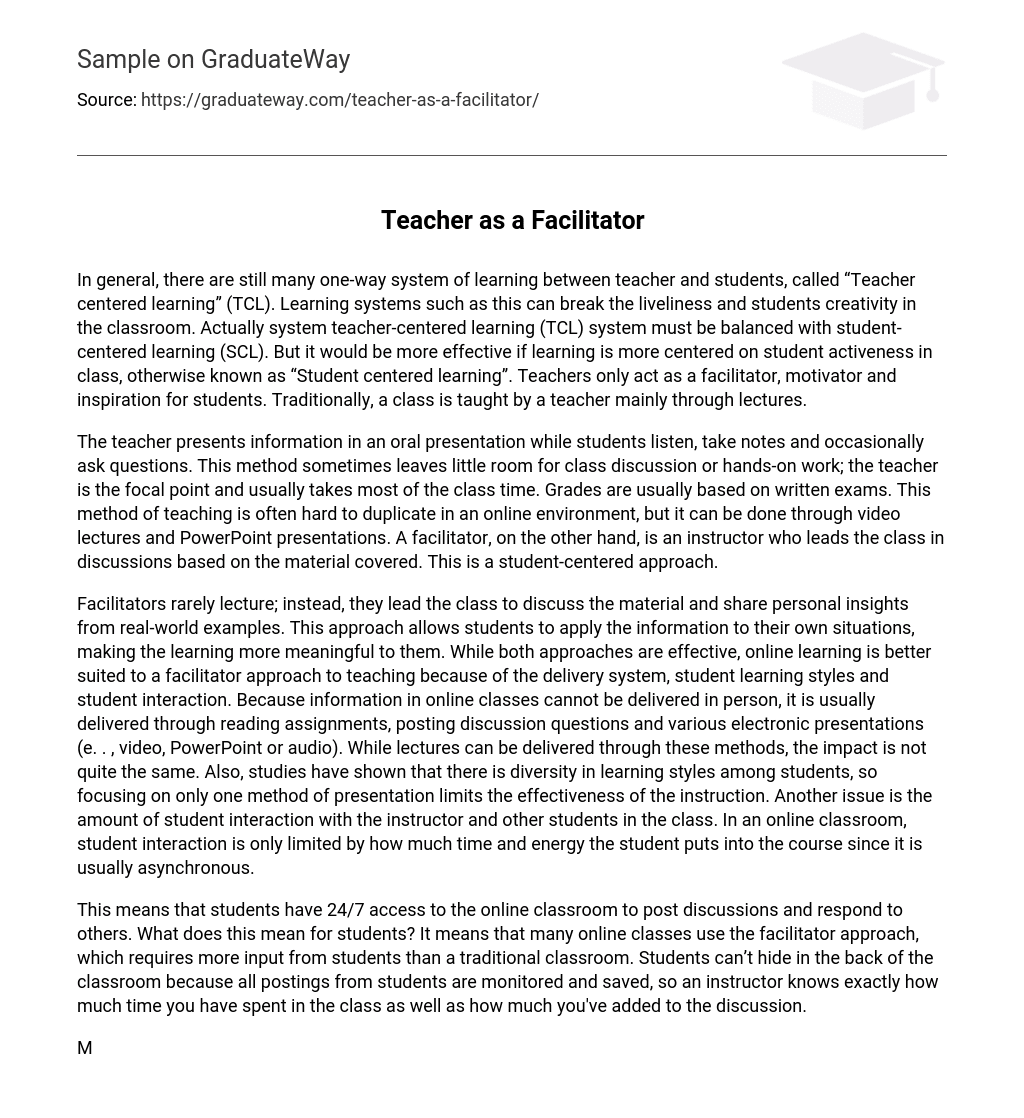In general, there are still many one-way system of learning between teacher and students, called “Teacher centered learning” (TCL). Learning systems such as this can break the liveliness and students creativity in the classroom. Actually system teacher-centered learning (TCL) system must be balanced with student-centered learning (SCL). But it would be more effective if learning is more centered on student activeness in class, otherwise known as “Student centered learning”. Teachers only act as a facilitator, motivator and inspiration for students. Traditionally, a class is taught by a teacher mainly through lectures.
The teacher presents information in an oral presentation while students listen, take notes and occasionally ask questions. This method sometimes leaves little room for class discussion or hands-on work; the teacher is the focal point and usually takes most of the class time. Grades are usually based on written exams. This method of teaching is often hard to duplicate in an online environment, but it can be done through video lectures and PowerPoint presentations. A facilitator, on the other hand, is an instructor who leads the class in discussions based on the material covered. This is a student-centered approach.
Facilitators rarely lecture; instead, they lead the class to discuss the material and share personal insights from real-world examples. This approach allows students to apply the information to their own situations, making the learning more meaningful to them. While both approaches are effective, online learning is better suited to a facilitator approach to teaching because of the delivery system, student learning styles and student interaction. Because information in online classes cannot be delivered in person, it is usually delivered through reading assignments, posting discussion questions and various electronic presentations (e. . , video, PowerPoint or audio). While lectures can be delivered through these methods, the impact is not quite the same. Also, studies have shown that there is diversity in learning styles among students, so focusing on only one method of presentation limits the effectiveness of the instruction. Another issue is the amount of student interaction with the instructor and other students in the class. In an online classroom, student interaction is only limited by how much time and energy the student puts into the course since it is usually asynchronous.
This means that students have 24/7 access to the online classroom to post discussions and respond to others. What does this mean for students? It means that many online classes use the facilitator approach, which requires more input from students than a traditional classroom. Students can’t hide in the back of the classroom because all postings from students are monitored and saved, so an instructor knows exactly how much time you have spent in the class as well as how much you’ve added to the discussion.
Most online classes require you to post answers to discussion questions regularly in order to receive participation points, whereas in a traditional class, the teacher only took roll. Some students may see this as a negative, but the truth is the student gets a lot out of the arrangement as well. The more you interact with the material and can apply it to your situation, the more you will be able to learn. 1. Teacher as Facilitator learning system which is the “Teacher Centered Learning” (TCL) will be limited to the role of teacher as facilitator.
The task here is only to guide teachers and guide the students to be more active in class in creativity and develop existing skills in students. Not only give them with a variety of lessons that can decrease student creativity. A teacher should involve students in learning activities in class, either in the form of presentations, question and answer, discussion, or other activities. 2. Teacher as motivator Teachers gives motivation and spirit to their students that can build the confidence from the students. A teacher as did not give a punishment if their student made a mistake in answering or doing exercise.
But the teacher will continue to support and motivate students to repair the mistake. Teachers must be able to build the character their students through a variety of activities that can enhance student creativity in building self-motivation in students. Teachers should always be constructive to adopt innovative new methods to motivate students to learn the children by placing their students as a center of learning, meaning the extent to which the material presented is not depends on the teachers and the curriculum but it depends on the students. 3.
Teacher as inspiration Teachers not only as a student assistant in the classroom, but also acts as a friend who can provide inspiration to their students. Here, teachers have an important role in building strong character in their students as a teacher trying to construct Therefore students thought the teacher should be an inspiration which can be an inspiration for the others. Based on Student Centered Learning, the teachers should be as a facilitator, motivator, and inspiration for students that can construct students’ creativity and their understanding.





